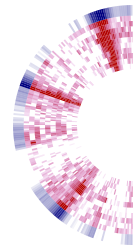Welcome to the Allen SDK¶
The Allen Software Development Kit houses source code for reading and processing Allen Brain Atlas data. The Allen SDK focuses on the Allen Brain Observatory, Cell Types Database, and Mouse Brain Connectivity Atlas.
Attention
As of October 2019, we have dropped Python 2 support and any files with a py2 dependency (for example analysis files) have been updated.

Allen Brain Observatory¶
The Allen Brain Observatory is a data resource for understanding sensory processing in the mouse visual cortex. This study systematically measures visual responses in multiple cortical areas and layers using two-photon calcium imaging of GCaMP6-labeled neurons targeted using Cre driver lines. Response characterizations include orientation tuning, spatial and temporal frequency tuning, temporal dynamics, and spatial receptive field structure.
The mean fluorescence traces for all segmented cells are available in the Neurodata Without Borders file format (NWB files). These files contain standardized descriptions of visual stimuli to support stimulus-specific tuning analysis. The Allen SDK provides code to:
- download and organize experiment data according to cortical area, imaging depth, and Cre line
- remove the contribution of neuropil signal from fluorescence traces
- access (or compute) dF/F traces based on the neuropil-corrected traces
- perform stimulus-specific tuning analysis (e.g. drifting grating direction tuning)

Allen Cell Types Database¶
The Allen Cell Types Database contains electrophysiological and morphological characterizations of individual neurons in the mouse primary visual cortex. The Allen SDK provides Python code for accessing electrophysiology measurements (NWB files) for all neurons and morphological reconstructions (SWC files) for a subset of neurons.
The Database also contains two classes of models fit to this data set: biophysical models produced using the NEURON simulator and generalized leaky integrate and fire models (GLIFs) produced using custom Python code provided with this toolkit.
The Allen SDK provides sample code demonstrating how to download neuronal model parameters from the Allen Brain Atlas API and run your own simulations using stimuli from the Allen Cell Types Database or custom current injections:

Allen Mouse Brain Connectivity Atlas¶
The Allen Mouse Brain Connectivity Atlas is a high-resolution map of neural connections in the mouse brain. Built on an array of transgenic mice genetically engineered to target specific cell types, the Atlas comprises a unique compendium of projections from selected neuronal populations throughout the brain. The primary data of the Atlas consists of high-resolution images of axonal projections targeting different anatomic regions or various cell types using Cre-dependent specimens. Each data set is processed through an informatics data analysis pipeline to obtain spatially mapped quantified projection information.
The Allen SDK provides Python code for accessing experimental metadata along with projection signal volumes registered to a common coordinate framework. This framework has structural annotations, which allows users to compute structure-level signal statistics.
See the mouse connectivity section for more details.
What’s New - 2.1.0 (July 16, 2020)¶
As of the 2.1.0 release: - behavior ophys nwb files can now be written using updated pynwb and hdmf - A warning has been added if you are using AllenSDK with outdated NWB files - A new documentation file has been added which will contain Visual Behavior specific terms for quick lookup
What’s New - 2.0.0 (June 11, 2020)¶
As of the 2.0.0 release:
- pynwb and hdmf version requirements have been made less strict
- The organization of data for ecephys neuropixels Neurodata Without Borders (NWB) files has been significantly changed to conform with NWB specifications and best practices
- CCF locations for ecephys neuropixels electrodes are now written to NWB files
- Examples for accessing eye tracking ellipse fit and screen gaze location data have been added to ecephys example notebooks
Important Note: Due to newer versions of pynwb/hdmf having issues reading previously released Visual Coding Neuropixels NWB files and due to the significant reorganization of their NWB file contents, this release contains breaking changes that necessitate a major version revision. NWB files released prior to 6/11/2020 are not guaranteed to work with the 2.0.0 version of AllenSDK. If you cannot or choose not to re-download the updated NWB files, you can continue using a prior version of AllenSDK (< 2.0.0) to access them. However, no further features or bugfixes for AllenSDK (< 2.0.0) are planned. Data released for other projects (Cell Types, Mouse Connectivity, etc.) are NOT affected and will NOT need to be re-downloaded
What’s New - 1.8.0 (June 6, 2020)¶
As of the 1.8.0 release:
- The biophysical module can now run both current and legacy all-active models.
- A pull request template was added to the repository.
- Duplicated demixer module was deprecated, and test coverage was added.
- Docker image for AllenSDK was updated.
For internal users: - The date_of_acquisition field is available for behavior-only Session data. - The CSV log was removed from BehaviorProjectCache - Fixed a bug so LIMS data served to BehaviorDataSession now all use the same timestamp source.
What’s New - 1.7.1 (May 5, 2020)¶
As of the 1.7.1 release:
- Added a bug fix to correct nightly tests of AllenSDK and prevent failure
- Added a bug fix to move nightly notebook tests to using production endpoint
What’s New - 1.7.0 (April 29, 2020)¶
As of the 1.7.0 release:
- Added functionality so internal users can now access eye_tracking ellipse fit data from behavior + ophys Session objects
- Added a new mixin for managing processing parameters for Session objects
- Update the monitor delay calculation to better handle edge cases; no longer provide a default delay value if encounter an error
- Added support for additional sync file line labels
- Fixed bug with loading line labels from sync files